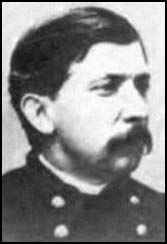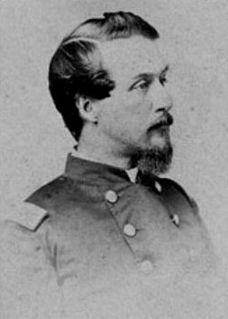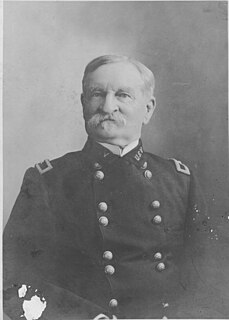 W
WThe Wounded Knee Massacre, also known as the Battle of Wounded Knee, was a domestic massacre of nearly three hundred Lakota people, by soldiers of the United States Army. It occurred on December 29, 1890, near Wounded Knee Creek on the Lakota Pine Ridge Indian Reservation in the U.S. state of South Dakota, following a botched attempt to disarm the Lakota camp. The previous day, a detachment of the U.S. 7th Cavalry Regiment commanded by Major Samuel M. Whitside intercepted Spotted Elk's band of Miniconjou Lakota and 38 Hunkpapa Lakota near Porcupine Butte and escorted them 5 miles (8.0 km) westward to Wounded Knee Creek, where they made camp. The remainder of the 7th Cavalry Regiment, led by Colonel James W. Forsyth, arrived and surrounded the encampment. The regiment was supported by a battery of four Hotchkiss mountain guns.
 W
WThe Wounded Knee Massacre, also known as the Battle of Wounded Knee, was a domestic massacre of nearly three hundred Lakota people, by soldiers of the United States Army. It occurred on December 29, 1890, near Wounded Knee Creek on the Lakota Pine Ridge Indian Reservation in the U.S. state of South Dakota, following a botched attempt to disarm the Lakota camp. The previous day, a detachment of the U.S. 7th Cavalry Regiment commanded by Major Samuel M. Whitside intercepted Spotted Elk's band of Miniconjou Lakota and 38 Hunkpapa Lakota near Porcupine Butte and escorted them 5 miles (8.0 km) westward to Wounded Knee Creek, where they made camp. The remainder of the 7th Cavalry Regiment, led by Colonel James W. Forsyth, arrived and surrounded the encampment. The regiment was supported by a battery of four Hotchkiss mountain guns.
 W
WThe Ghost Dance War was an armed conflict in the United States between the Lakota Sioux and the United States government from 1890 until 1891. It involved the Wounded Knee Massacre wherein the 7th Cavalry massacred around 300 unarmed Lakota Sioux, primarily women, children, and elders, at Wounded Knee on December 29, 1890. The Ghost Dance War ended when Sioux leader Kicking Bear surrendered on January 15, 1891.
 W
WWilliam Grafton Austin was an American enlisted man and officer in the U.S. Army who served with the 7th Cavalry Regiment during the Indian Wars. Austin received the Medal of Honor for extraordinary gallantry at the Battle of Wounded Knee, but now called the Wounded Knee Massacre, on December 29, 1890.
 W
WSpotted Elk, was a chief of the Miniconjou, Lakota Sioux. He was a son of Miniconjou chief Lone Horn and became a chief upon his father's death. He was a highly renowned chief with skills in war and negotiations. A United States Army soldier, at Fort Bennett, coined the nickname Big Foot – not to be confused with Oglala Big Foot.
 W
WJohn Rutter Brooke was one of the last surviving Union generals of the American Civil War when he died at the age of 88.
 W
WEugene Asa Carr was a soldier in the United States Army and a general in the Union Army during the American Civil War. He was awarded the Medal of Honor for his actions at the Battle of Pea Ridge.
 W
WBenjamin Harrison Cheever Jr. was a US Army officer who received the Medal of Honor for his actions during the Indian Wars. He was born in Washington, D.C.
 W
WClara Dorothy Bewick Colby was a British-American lecturer, newspaper publisher and correspondent, women's rights activist, and suffragist leader. Born in England, she immigrated to the US, where she attended university and married the former American Civil War general, later Assistant United States Attorney General, Leonard Wright Colby. In 1883, she founded The Woman's Tribune in Beatrice, Nebraska, moving it three years later to Washington, D.C.; it became the country's leading women's suffrage publication. She was an advocate of peace and took part in the great peace conference at San Francisco during the exposition. She also spoke on behalf of the soldiers of the Spanish War. During the Spanish–American War (1898), she was officially appointed as war correspondent, the first woman to be so recognized.
 W
WFirst Sergeant Mosheim Feaster was an American soldier in the U.S. Army who served with the 7th U.S. Cavalry during the Indian Wars. He was one of twenty men awarded the Medal of Honor for extraordinary gallantry at the Battle of Wounded Knee, but now called the Wounded Knee Massacre, on December 29, 1890. He later served in the Spanish–American War.
 W
WJames William Forsyth was a U.S. Army officer and general. He was primarily a Union staff officer during the American Civil War and cavalry regimental commander during the Indian Wars. Forsyth is best known for having commanded the 7th Cavalry at the Wounded Knee Massacre on December 29, 1890 during which more than 150 men, women, and children of the Lakota were killed and 51 were wounded.
 W
WErnest Albert Garlington was a United States Army general who received the Medal of Honor during the Indian Wars.
 W
WEdward Settle Godfrey was a United States Army Brigadier General who received the Medal of Honor for leadership as a captain during the Indian Wars.
 W
WJohn Chowning Gresham was an officer in the United States Army who was a recipient of the Medal of Honor for his actions during the Indian Wars.
 W
WGuy Vernor Henry was a military officer and Medal of Honor recipient who served as an early Governor of Puerto Rico.
 W
WRobert Lee Howze was a United States Army major general who was a recipient of the Medal of Honor for his actions during the Indian Wars.
 W
WKicking Bear was an Oglala Lakota who became a band chief of the Miniconjou Lakota Sioux. He fought in several battles with his brother, Flying Hawk and first cousin, Crazy Horse during the War for the Black Hills, including Battle of the Greasy Grass.
 W
WGeorge Loyd, whose last name was occasionally spelled "Lloyd," was a United States Army soldier. He fought in the Battle of the Little Big Horn and in the Battle of Wounded Knee, now called the Wounded Knee Massacre, receiving the Medal of Honor for his actions in the latter.
 W
WNelson Appleton Miles was an American military general who served in the American Civil War, the American Indian Wars, and the Spanish–American War. From 1895 to 1903, he served as the last Commanding General of the United States Army before the office was abolished.
 W
WMyles Moylan was a United States Army officer who fought at the Battle of the Little Bighorn and received the Medal of Honor. His award came for gallantry during the American Indian Wars.
 W
WThomas Sullivan was a United States Army soldier and a recipient of America's highest military decoration—the Medal of Honor—for his actions in the Battle of Wounded Knee, but now called the Wounded Knee Massacre.
 W
WTouch the Clouds was a chief of the Minneconjou Teton Lakota known for his bravery and skill in battle, physical strength and diplomacy in counsel. The youngest son of Lone Horn, he was brother to Spotted Elk, Frog, and Hook Nose. There is evidence suggesting that he was a cousin to Crazy Horse.
 W
WCharles Albert Varnum was a career United States Army officer. He was most noted as the commander of the scouts for George Armstrong Custer in the Little Bighorn Campaign during the Great Sioux War, as well as receiving the Medal of Honor for his actions in a conflict at Drexel Mission following the Wounded Knee Massacre.
 W
WSergeant Paul H. Weinert was an American soldier in the U.S. Army who served with the 1st U.S. Artillery during the Indian Wars. He was one of twenty men who received the Medal of Honor for gallantry at what was then called the Battle of Wounded Knee, but now commonly called the Wounded Knee Massacre, taking charge of the battery when his commanding officer was severely wounded, on December 29, 1890.
 W
WFrank Wheaton was a career military officer in the United States Army during the American Civil War and Indian Wars. He also was military commander over south Texas during the Garza Revolution.
 W
WSamuel M. Whitside was a United States Cavalry officer who served from 1858 to 1902. He commanded at every level from company to department for 32 of his 43 years in service, including Army posts such a Camp Huachuca, Jefferson Barracks, and Fort Sam Houston, the Departments of Eastern Cuba and Santiago and Puerto Principe, Cuba, commanded a provisional cavalry brigade, a squadron in the 7th Cavalry Regiment, and a troop and platoon in the 6th Cavalry Regiment. The pinnacle of his career was serving as the commanding general of the Department of Eastern Cuba before retiring in June 1902 as a brigadier general in the U.S. Army.